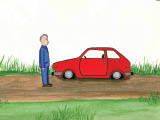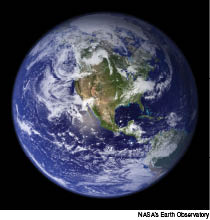During the 41 years that I taught high
school physics, I learned that getting kids to work on understanding
concepts was the hard part of teaching. The concepts were easy if the
student could see some application to their daily lives of what they
were studying. If they did not see relevance they were not going to
work on understanding. To that end I used to title our unit on
thermodynamics “Break the Thermo Law and You Don’t Survive!” The three
laws of thermodynamics are fundamental truths that apply to all of
science. Theories that break the three laws of thermodynamics do not
survive, and those laws have a great deal to do with cosmology and
questions about creation. We would like to state these laws, and try to
point out their application to questions related to life, death, and
how we live our lives.
THE FIRST LAW:
THE TOTAL INCREASE IN THERMAL ENERGY OF A SYSTEM IS THE SUM OF THE WORK
DONE ON IT AND THE HEAT ADDED TO IT.
I used to tell my classes that this law says “You don’t get something
for nothing.” What does it take to run your car? One student said
“$2.00 a gallon.” We had learned how to calculate on the blackboard how
much energy a gallon of gasoline produces, so I would calculate how far
you ought to be able to drive your car on a gallon of gas. The answer
usually came out to be something close to 1,000 miles. “Shoot--he can’t
get that crate of his out of the parking lot on a gallon of gas”
another student volunteered. “What’s the inconsistency?” I would ask,
and then answer my own question by screaming “The First Law of
Thermodynamics!”

The point is that the total thermal energy added to the
car (the burning gasoline) will never be equal to the work done by the
engine. There will always be energy lost to heat the engine, to
friction, to incomplete combustion, and a variety of other energy
consumption problems. This is simply a thermal statement of the Law of
Conservation of Energy, and it applies to everything in life. We will
never have cars, motors, or heating systems that are 100 percent
efficient. Perpetual motion will never happen. There is always a price
to pay for any energy that you use.
Planet Earth, the solar system, the galaxy, and in fact, the cosmos all
operate in conformance to the first law. If the cosmos started with a
massive singularity of energy, then that total energy is equal to the
work that has been done in the cosmos and the energy that still exists
within it. Proposing that something can “pop into existence out of
nothing” is not a possibility. Energy systems can change, but the first
law will still apply. Quantum mechanics may show us ways in which

energy
systems change that are new to us, but the total
energy of the cosmos has not changed even in quantum reactions. The
fact that there are newly understood mechanisms of change does not
invalidate the first law. Irtrons, branes, super strings, einsteinium
holes, black holes, white holes, and worm holes do not change the laws.
They change the ways in which the laws are applied, sometimes with
remarkable methods, but you still do not get something from nothing.
At the beginning there was an incredible concentration of energy
created at the point at which time and space were created. We know from
Einstein’s famous equation
E=
mc2 that this energy can
appear as mass. Those of us who believe in God believe that “God is
light” applies to this situation, that God just took some of His own
essence and produced the singularity that led to the cosmos. Those who
reject God’s existence have to believe that some entity that was extra
dimensional did the same thing, but without wisdom, intelligence, or
design. While we can argue about that entity, we cannot argue about the
laws that describe how that initial singularity came to be the physical
world in which we live, and became us as well. The first law of
thermodynamics describes that in a profound way, and gives our world
order, function, and predictability.
THE SECOND LAW:
IN ANY ENERGY CONVERSION, SOME ENERGY IS LOST IN THE FORM OF HEAT WHICH
CANNOT BE RECOVERED AS USEFUL ENERGY.
This statement of the second law is known as the Clausius statement,
and what it describes is heat death. In any closed system, things tend
to move toward a condition of disorder--called entropy. The law does
not say that energy is destroyed--that would violate the first law. It
simply says that there is always some energy that cannot be recovered
in any physical process. Things always move toward a condition of
disorder.
I used to have a student put a spoon on the table and while I was
talking to the class, one end of the spoon would get hot and start to
smoke. I would deny it was hot by picking it up at the other end and
then putting it back right where I found it--where it continued to get
hotter and hotter on one end. The class would go ballistic, and I would
ask them what the problem was. After a barrage of nutty answers (it’s
haunted, it’s an illusion, etc.) I would point out that they had faith
in the second law. Common sense tells them that order (the cold end)
cannot exist at the same time as disorder. I had an induction coil
under the desk top that was heating the spoon, but we all know that one
end cannot be hot and the other end cold. Gases diffuse because of the
second law. We get old because of the second law. My favorite example
is a teenager’s room, which becomes more and more disordered with time
in conformance to the second law.
It is important to understand that all of these examples and
discussions assume that no one is improving the order from the outside.
If mother comes along and makes you clean up your room, then the room
is no longer a closed system. Organizing energy is added from the
outside. The second law applies to systems in which no organizing
energy is added externally to the system. (The induction coil made the
spoon an open system.)
There are enormous implications of the second law for cosmology. The
second law says that like us, all stars and all galaxies will
eventually die. The cosmos is not eternal, and there had to be a
specific point at which there was no energy in an unusable form in the
cosmos--no entropy. The biblical statement, that there was a beginning,
is strongly attested to by the second law. We would like to point out
that it is incorrect to apply the second law to the earth or to
anything on the earth. Some creationists have attempted to attack
evolution on the basis of the second law, but the earth is not a closed
system. Photosynthesis works because the sun is adding energy to the
earth. Biological systems can have energy added to them by any number
of methods--light, radiation, heat, thermal vents, etc., improving
their order. The second law verifies many biblical statements, but it
is not a tool to attack evolution.
THE THIRD LAW:
ABSOLUTE ZERO IS A LIMIT THAT, LIKE THE SPEED OF LIGHT, CAN BE
APPROACHED BUT NOT REACHED.
This statement of the third law is called the Nernst heat theorem, and
like the other two laws, it just makes sense. If you were to reach
absolute zero, then all atomic motion would stop. If electrons stop
orbiting the positive center of atoms, what happens? Opposites attract,
and the electrons would simply be drawn into the nucleus. Matter would
simply dissolve. It is interesting that biblical passages talk about
the fact that at the end of time matter will dissolve (2 Peter 3:10).
If you stop time and all motion which depends upon time, then the third
law

describes positively what would
happen--matter would dissolve. The point is that the design of the
cosmos shows wisdom and purpose.
The laws we have mentioned and the multiplicity of other laws that are
known to the sciences, all show that the creation is logical,
comprehendible, and open to our understanding and by using the creation
we can sustain ourselves on this planet. The evidence for the existence
of God and for God’s creative action in the earth can be seen “through
the things He has made” (Romans 1:19-22). Understanding what God has
done and something about how He has done it is what science is about,
and it is a wonderful, useful, practical way to live and
grow--physically and intellectually.
Note: Laws are quoted from the textbook
Physics: Principles and Problems,
Glencoe Publications of Macmillan/McGraw Hill, PO Box 508, Columbus,
Ohio 43216, pages 256-259.


 The point is that the total thermal energy added to the
car (the burning gasoline) will never be equal to the work done by the
engine. There will always be energy lost to heat the engine, to
friction, to incomplete combustion, and a variety of other energy
consumption problems. This is simply a thermal statement of the Law of
Conservation of Energy, and it applies to everything in life. We will
never have cars, motors, or heating systems that are 100 percent
efficient. Perpetual motion will never happen. There is always a price
to pay for any energy that you use.
The point is that the total thermal energy added to the
car (the burning gasoline) will never be equal to the work done by the
engine. There will always be energy lost to heat the engine, to
friction, to incomplete combustion, and a variety of other energy
consumption problems. This is simply a thermal statement of the Law of
Conservation of Energy, and it applies to everything in life. We will
never have cars, motors, or heating systems that are 100 percent
efficient. Perpetual motion will never happen. There is always a price
to pay for any energy that you use. energy
systems change that are new to us, but the total
energy of the cosmos has not changed even in quantum reactions. The
fact that there are newly understood mechanisms of change does not
invalidate the first law. Irtrons, branes, super strings, einsteinium
holes, black holes, white holes, and worm holes do not change the laws.
They change the ways in which the laws are applied, sometimes with
remarkable methods, but you still do not get something from nothing.
energy
systems change that are new to us, but the total
energy of the cosmos has not changed even in quantum reactions. The
fact that there are newly understood mechanisms of change does not
invalidate the first law. Irtrons, branes, super strings, einsteinium
holes, black holes, white holes, and worm holes do not change the laws.
They change the ways in which the laws are applied, sometimes with
remarkable methods, but you still do not get something from nothing.
 describes positively what would
happen--matter would dissolve. The point is that the design of the
cosmos shows wisdom and purpose.
describes positively what would
happen--matter would dissolve. The point is that the design of the
cosmos shows wisdom and purpose.